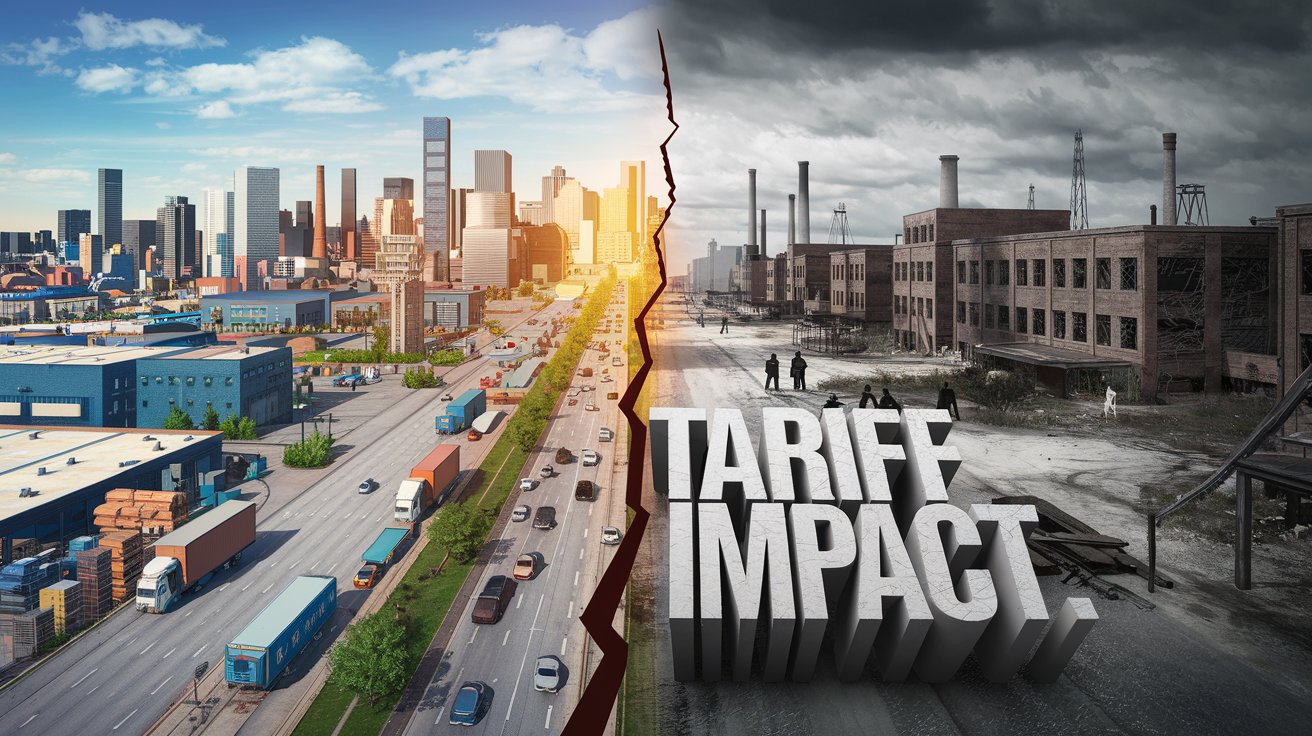Table of Contents
The Impact of Trump’s Tariffs on Canadian Cities
Canada and the United States have always had a strong trade relationship, but recent policies from the U.S. President Donald Trump have created new challenges. The U.S. has imposed tariffs on Canadian exports, adding extra costs to goods that cross the border. These tariffs include a 25% tax on non-energy exports like steel, aluminum, and auto parts, and a 10% tax on energy products like crude oil and natural gas.
For Canada, these tariffs could have serious consequences. The U.S. is by far Canada’s biggest trading partner, buying 77% of all Canadian exports. Many cities and industries in Canada depend on this trade, so these new taxes could mean job losses, factory shutdowns, and economic slowdowns.
Not all parts of Canada will feel the impact in the same way. Some cities are more exposed than others, especially those that rely on energy, manufacturing, and auto production. Let’s take a closer look at which Canadian cities are at the highest risk and how these tariffs could change the economy.
Which Provinces are the Most Vulnerable to Tariffs?
Some provinces will be hit harder than others, mostly because of their strong ties to U.S. trade. Alberta, New Brunswick, Ontario, and Quebec are the most vulnerable, each for different reasons.
Alberta and New Brunswick are both deeply connected to the energy sector, which relies on exports to the U.S. In Alberta, oil and gas make up over half of the province’s total exports. In New Brunswick, petroleum products account for 60% of exports, largely due to the Irving Oil Refinery—the biggest in Canada.
Even though the tariffs on energy are lower than those on other goods, the 10% tax still creates a major challenge. These added costs could make Canadian oil and gas less competitive, which could lead to lower sales, fewer jobs, and less investment in these regions.
Ontario is Canada’s biggest exporter, sending over C$200 billion worth of goods to the U.S. every year. About 85% of these exports are manufactured goods, mostly related to the auto industry. The problem is that auto production between Canada and the U.S. is tightly connected—parts and vehicles cross the border multiple times before they are finished.
With Trump’s tariffs putting a 25% tax on auto parts, Ontario’s economy could suffer. If the cost of making cars rises, U.S. companies might move production elsewhere, leading to plant shutdowns and job losses in cities like Windsor and Oshawa.
Quebec is one of the world’s biggest aluminum producers, and the U.S. is its largest customer. About 85% of Quebec’s aluminum exports go to the U.S., making it highly vulnerable to trade restrictions. The new tariffs place a 25% tax on aluminum and steel, which means that businesses in Quebec could see reduced demand, layoffs, or even factory closures.
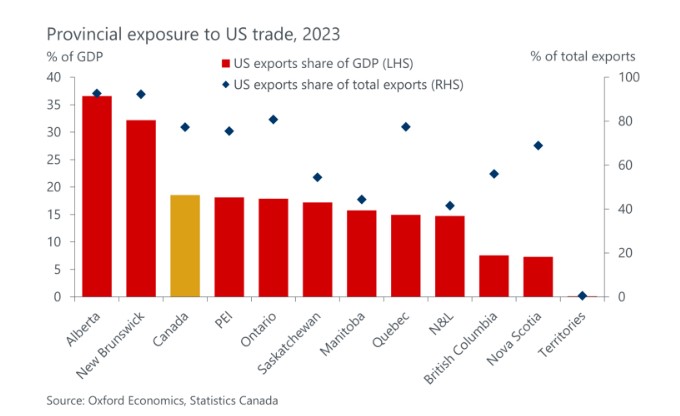
The Canadian Cities Most Affected by Tariffs
While the entire country will feel the effects of these tariffs, some cities are in far greater danger than others. Those that rely heavily on exports to the U.S. will face the most severe economic challenges.
Saint John is at the top of the list when it comes to risk. The city’s economy is centered around the Irving Oil Refinery, which processes 320,000 barrels of crude oil every day, and 96% of its exports go to the U.S. Since the energy sector is now subject to a 10% tariff, Saint John could see job cuts and economic instability.
Calgary, known as Canada’s energy capital, is another city that will be hit hard. The city exported C$119 billion worth of goods to the U.S. in 2023, most of it from oil and gas. Since the tariffs will increase costs, companies in Calgary could face reduced profits and job losses. The impact could even trickle down into the housing market, where falling employment could mean lower home values.
Windsor’s economy is closely tied to the auto industry. The city is home to Ford and Stellantis manufacturing plants, and 85% of its exports are related to vehicle production. The Ambassador Bridge, which connects Windsor to Detroit, is the busiest trade crossing in North America, handling about 25% of Canada’s total exports.
If the tariffs on auto parts remain in place, Windsor could see factory closures, layoffs, and economic downturns. The city’s entire economy is built around cross-border trade, so any disruption will have widespread consequences.
While Saint John, Calgary, and Windsor are the most exposed, other cities will also feel the impact of these tariffs. Montreal and Saguenay will struggle because of their reliance on aluminum and steel exports. Hamilton, known as Canada’s “Steel City,” will be heavily affected by the 25% tariff on steel. Kitchener-Waterloo, Brantford, and Guelph specialize in auto parts, which means they could also suffer from Trump’s tariffs.
Even though some cities, like Vancouver and Halifax, have more diversified economies and trade with Asia or Europe, most Canadian cities still rely on the U.S. as their primary trade partner. That means very few places will escape the consequences of these tariffs completely.
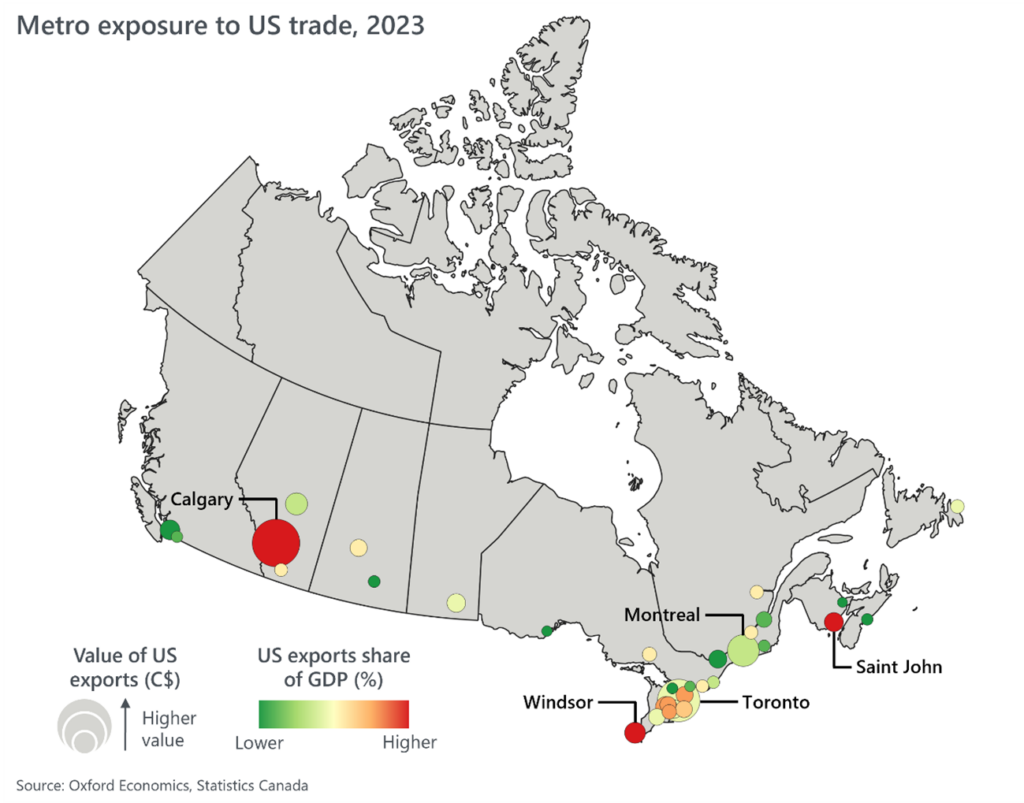
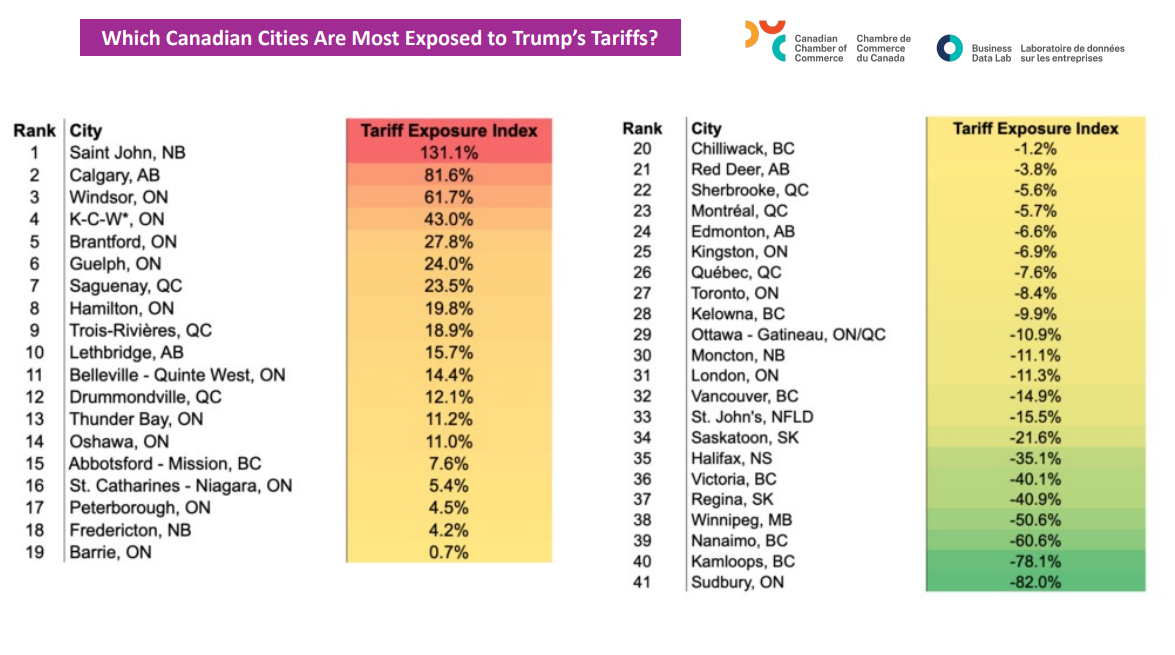
How Will Tariffs Affect Canada’s Industries?
The most heavily impacted industries include auto manufacturing, energy, and steel and aluminum production. In Ontario and Quebec, the auto sector could face rising costs due to tariffs on auto parts. Southwestern Ontario cities like Windsor, Oshawa, Guelph, and Brantford depend on the auto industry, and any disruption could mean plant closures or layoffs.
The energy sector, concentrated in Calgary and Saint John, will also feel the effects of the 10% tariff on Canadian energy exports. While this is lower than the 25% rate applied to other industries, it could still discourage investment in Canada’s oil and gas industry.
For Quebec and Ontario’s steel and aluminum producers, the 25% tariff could lead to reduced demand from the U.S., which remains the largest buyer of these materials. Cities like Saguenay, Trois-Rivières, and Hamilton could see factories reduce output or even shut down if they struggle to compete with global markets.
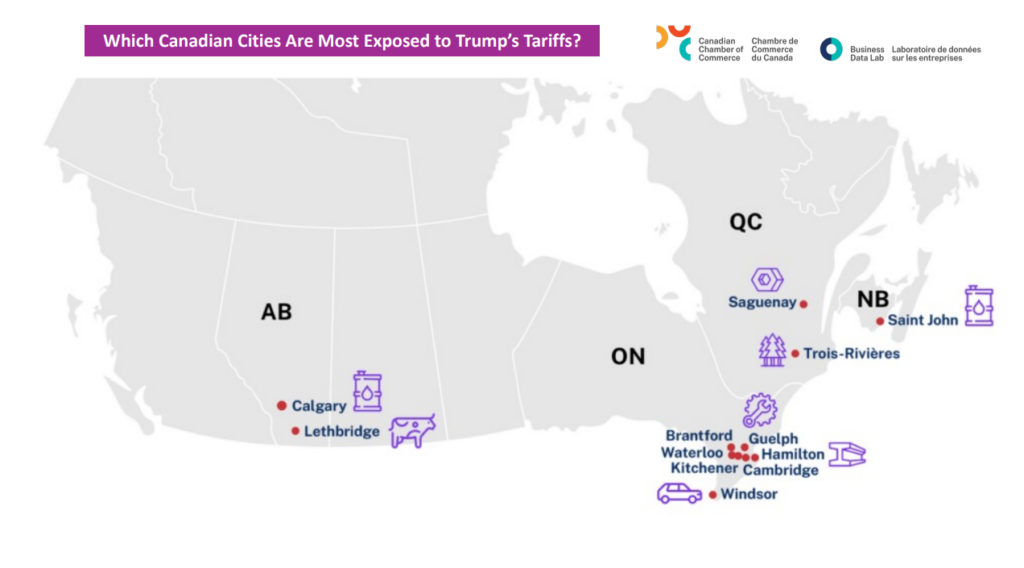
The Real Estate Impact of Tariffs
Beyond trade and employment, these tariffs could also have an impact on the Canadian housing market. Cities in Canada that rely on affected industries could see lower demand for housing, leading to falling property prices. In Hamilton, for example, a slowdown in steel production could mean fewer jobs, lower wages, and ultimately a weaker real estate market. Windsor, which already has an economy heavily dependent on auto manufacturing, could see home prices decline if tariffs on auto parts force factory closures.
Similarly, in Calgary, a weakened energy sector could slow down home sales and reduce housing prices. Saint John’s real estate market may also take a hit if refinery jobs disappear due to the 10% tariff on Canadian energy exports.
What Comes Next?
Once the U.S. moves forward with these trade barriers, Canada’s economy—particularly in export-dependent cities—will face serious challenges. Industries like auto manufacturing, energy, and steel production could see rising costs, job losses, and economic slowdowns. Cities such as Saint John, Calgary, and Windsor will be hit the hardest, but the ripple effects will be felt across the country.
For homeowners and investors, these economic shifts could directly impact real estate markets, leading to lower demand and declining property values in affected cities. Whether you’re a homebuyer looking for opportunities or a seller navigating uncertain conditions, staying informed is key. If you’re a homeowner, subscribe to our newsletter to stay up to date on the current housing market.
And if you’re a buyer, sign up for Valery AI’s email notifications to get real-time updates on discounted properties in these regions—so you can make smart, strategic decisions in a changing market.
